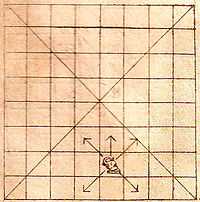Sittuyin

Sittuyin (Burmese: စစ်တုရင်), also known as Burmese chess, is a variant of chess that is a direct offspring of the Indian game of chaturanga which arrived in 8th century AD. Sit is the modern Burmese word for army or war ; the word sittuyin can be translated as representation of the four characteristics of army—chariot, elephant, cavalry and infantry.
In its native land the game has been largely overshadowed by Western (international) chess, although it remains popular in the northwest regions.
Board
The sittuyin board consists of 64 squares, 8 rows and 8 columns, without alternating colors. It also consists of two diagonal lines across the board known as sit-ke-myin (general's lines).
Pieces and their moves
Pieces are commonly made in wood and sometimes in ivory. The height of the pieces is varied by class. The official colors of the pieces are red and black.


- Sit-ke (general)
- Equivalent to a chess queen; it can move one step in any diagonal direction (as fers in shatranj).
- Sin (elephant)
- Equivalent to a chess bishop; it can move one step in any diagonal direction or one step forward (as silver general in shogi).
- Myin (horse)
- Equivalent to a chess knight; it can jump two horizontal squares and one vertical square or two vertical squares and one horizontal square, as in Western chess.
- Yahhta (chariot)
- Equivalent to a chess rook; it can move any number of free squares along four orthogonal directions.
- Nè (feudal lord)
- Equivalent to a chess pawn; it can move one step forward but cannot retreat. It captures one diagonal step forward as in Western chess.
Rules

Only feudal lords (pawns) are on the board in the initial position. The game starts with the Red player (depicted here having white pieces), followed by the Black player, placing their other pieces arbitrarily on their own halves of the board (known as sit-tee or troops deployment): chariots can be put on any square on the back rank. In official tournaments, a small curtain is used on the middle of the board to prevent the players seeing each other's deployment during the sit-tee phase. One of the possible game openings is shown in the diagram.
Feudal lords promote to general when they reach diagonal lines marked on the board. The promotion is possible only if that player's general has been captured. If the player has a feudal lord on a promotion square and his or her general is no longer on the board, the player can (if he wishes to) promote the feudal lord to general instead of making a move. A feudal lord which passes the promotion square cannot promote anymore.
The goal of the game is to khwè (checkmate) the opponent's king. Putting the opponent in stalemate is not allowed.
In the version reported in A History of Chess in 1913, a game of sittuyin had three stages:
- Eight moves each: the sit-tee stage described above, but no restriction on chariot placing; Murray did not mention a curtain. Also, a player could put a piece where one of his pawns is, and in the same move put that pawn in a free square behind his row of pawns.
- Second stage: in each move, each player moves any one of his pieces (not a pawn) to any other empty place in his own half of the board, ignoring the usual move rules. Or he can move a pawn one square forwards and this ends the second stage and the third stage starts.
- Ordinary play, obeying the rules for piece moves.
Dice rules
Anne Sunnucks writes that three dice were thrown and each player made three moves at a time.[1]
See also
- Short assize—a type of medieval European chess
References
- ↑ Anne Sunnucks, The Encyclopaedia of Chess, St. Martin's Press, 1970, pp. 97–98.
Bibliography
- Maung Maung Aye (1971) . Sittuyin: Traditional Myanmar Chess.
- Murray, H. J. R. (1913). A History of Chess (Reissued ed.). Oxford University Press. ISBN 0-19-827403-3.
- Pritchard, D. B. (1994). "Burmese chess". The Encyclopedia of Chess Variants. Games & Puzzles Publications. pp. 31–34. ISBN 0-9524142-0-1.
External links
- Sittuyin by Hans L. Bodlaender, The Chess Variant Pages
- Sittuyin, the Burmese Chess by Jean-Louis Cazaux
- Burmese Traditional Chess by Dr. Peter Nicolaus, The Chess Variant Pages
- How to Play Sittuyin Ancientchess.com